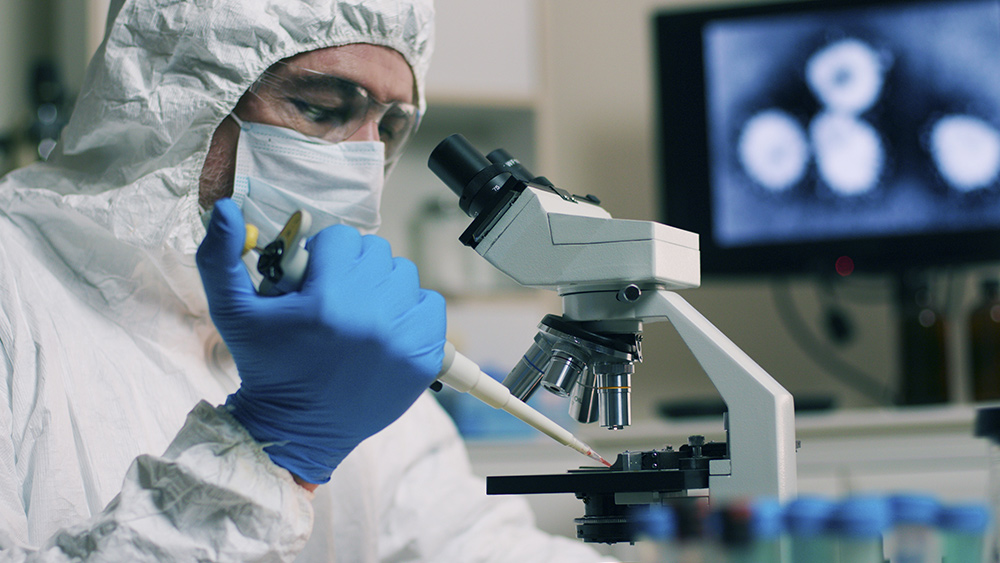Space thug: Chinese satellite seen grabbing and pulling another satellite out of orbit
02/25/2022 / By Kevin Hughes

A Chinese satellite was seen grabbing another satellite and taking it out of its normal geosynchronous orbit before placing it into a “super-graveyard drift orbit.”
The move has raised questions about the potential uses of these kinds of satellites designed to maneuver close to other satellites for inspection or handling. It has also increased growing concerns about China’s space program. (Related: China launches what experts fear is a “satellite-crushing weapon.”)
Last January 22, China’s Shijian-21 satellite or SJ-21 departed from its common position in orbit during daylight hours when observations were difficult to make with optical telescopes. SJ-21 was then seen making a “large maneuver” to close in on another satellite, a BeiDou Navigation System satellite.
SJ-21 then picked the dead satellite out of its usual geosynchronous orbit and put it a few hundred miles away in what is called a graveyard orbit. These distant orbits are booked for obsolete satellites at the end of their lives and are designed to decrease the risk of accident with operational assets.
The uncommon movement was seen by telescopes belonging to commercial space awareness firm Exoanalytic Solutions. During a recent webinar hosted by the Center for Strategic and International Studies (CSIS), Exoanalytic Solutions’ Space Situational Awareness Chief Architect Brien Flewelling said the SJ-21 satellite “appears to be functioning as a space tug.”
The United States Space Force has been progressively turning to commercial space companies to supply a variety of data and services to boost its situational awareness, and the Joint Task Force-Space Defense awarded Exoanalytic Solutions a contract in 2021 to give space domain data.
“Comms, data relay, remote sensing and even ISR and some other things – [these] capabilities are increasingly available in the commercial market,” Space Force Deputy Lt. Gen. David Thompson said last year.
SJ-21’s actions has potential military use
Shijian-21 or SJ-21 was launched in October 2021. The satellite is officially called an On-Orbit Servicing, Assembly and Manufacturing (OSAM) satellite, a wide class of satellites equipped with capabilities to get close to and communicate with other satellites.
Such systems allow a wide range of functions, such as stretching the life of existing satellites, assembling satellites in orbit or performing other maintenance and repairs. SJ-21 was designed to “test and verify space debris mitigation technologies,” according to Chinese state news outlets.
SJ-21’s recent action raises questions and concerns about these kinds of satellites and their potential for military use.
Todd Harrison, director of CSIS’s Aerospace Project, said in an interview with Breaking Defense that SJ-21’s moves present “more questions than answers.” He added that while people can watch the satellite’s actions, “the intent behind it and what China plans to do with this technology is a more subjective assessment.”
SJ-21 has already made headlines with its questionable action. Last November, just a month after its launch, an unidentified object was seen circling alongside SJ-21. The Space Force named the unknown object as a spent apogee kick motor, but it was also said that it might have been an experimental payload intended to test SJ-21’s ability to carry out remote operations and maneuver other satellites.
The U.S. Air Force’s China Aerospace Studies Institute (CASI) released a report on Shijian-21 immediately after its unknown companion came.
The report said: “Even Chinese media, academics and bloggers agree with Western analysts that remote proximity operation capabilities and robotic arm technologies are dual-use,” which means that they have potential military applications in addition to scientific or utility uses. The report mentions unproven claims that SJ-21 might have some form of net employed to catch space debris, claims which also came out on social media.
Studying the potential uses of these dual-use satellites is challenging. As CASI notes, while SJ-21’s previous actions show “technology to potentially enable weapons or reconnaissance capabilities,” they are also perfectly in line with China’s peaceful economic and scientific goals in space, particularly related to debris removal.
Even so, if SJ-21 can seize a dead satellite and move it out of orbit, there is likely nothing to stop it from doing the same thing to an operational satellite that the American military relies upon. It is crucial to note that the U.S. is also seeking on-orbit servicing capabilities that will likely draw related concerns from America’s competitors.
Northrop Grumman is developing a satellite with DARPA-made robotic arm that is able to perform “detailed inspections, relocations of client vehicles or simple repairs such as releasing a solar array that is stuck or an antenna that doesn’t deploy properly.” It is projected to launch in 2024.
Pentagon already concerned about China’s space capabilities
These new capabilities in orbit of China highlight concerns the Department of Defense has been voicing in recent years.
James Dickinson, commander of U.S. Space Command, told Congress last year that Chinese satellites like SJ-21 and others “could be used in a future system for grappling other satellites.”
Way back in 2013, there had been reports of Chinese satellites using robotic arms to seize other satellites. A robotic arm launched aboard the Tianhe module of China’s Tiangong space station had exhibited similar capabilities.
And those concerns of the Pentagon and Space Command aren’t unfounded. In another direct case of this probable threat, an American spy satellite was stalked closely in 2020 by a Russian “space apparatus inspector” believed to have capabilities akin to SJ-21. Manipulating one satellite close to another in orbit is a technologically complex motion and there is always the possibility of an accidental collision happening during one of these operations.
There are also concerns about enemy satellites with more destructive powers such as high-powered microwaves or the ability to shoot projectiles. Any satellite that has the ability to move in close proximity to another satellite could possibly perform an array of attacks such as jamming transmissions, blinding sensors, spraying aerosols on solar panels and optics and physically employing or moving it out of orbit like Shijian-21’s current operation.
With all of these information, it’s no wonder Space Force has enlarged its Geosynchronous Space Situational Awareness Program, which aims at monitoring other satellites in the same orbit as SJ-21 where many of America’s critical early warning and spy satellites are located.
Some Pentagon leaders argued that declassification of America’s space-based capabilities could provide deterrence and promote support for Space Force. As Shijian-21’s recent moves prove, there is an urgent need for the U.S. to be able to defend its assets in distant orbit.
More related stories:
Space arms race heats up as Russia admits to destroying a satellite with a space missile.
Pentagon: China’s space weapons program “on the march.”
Is Putin’s “Star Warrior” weapon a threat to Nato satellites?
New satellite will test whether magnets can be used to collect space debris.
Watch the video below to know how China’s new “destructive” weapons can “blind” U.S. satellites.
This video is from the End Time News channel on Brighteon.com.
Follow Space.news to know more about space satellites.
Sources include:
Submit a correction >>
Tagged Under:
America, big government, China, Department of Defense, future tech, inventions, military tech, national security, Pentagon, robotics, robots, satellite, Shijian-21 satellite, SJ-21, Space, weapons technology
This article may contain statements that reflect the opinion of the author
RECENT NEWS & ARTICLES
COPYRIGHT © 2017 BIG GOVERNMENT NEWS




















